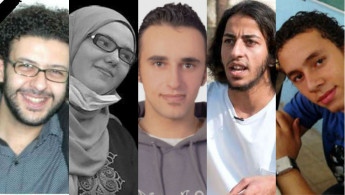United by a dream, killed by the state
They came from different political backgrounds and lived different lives, but all were united by a dream.
Khaled, Ahmad, Mina, Jika and Hala all wanted to live in a country of freedom and dignity. Instead they were killed by bullets, police torture and the army's armoured vehicles.
Al-Araby al-Jadeed revists the stories of these revolutionaries.
Khaled Said: a revolutionary icon
Khaled Said, 28 was beaten to death by two police officers 6 June 2010 after his arrest in an internet cafe in Alexandria. The officers smashed his body and head against objects as they marched him outside, before taking him to a nearby building and killed. His crime? According to the AP news agency, Said had posted a video on the internet showing police sharing the proceeds of a drug bust.
A photograph of Said after his death was leaked on the internet, showing his face brutally disfigured by the police beating. The picture sparked a campaign of dissent, We are all Khaled Said, and his case was used by revolutionaries across Egypt as a prime example of the brutality and corruption of the state.
However, Said's family welcomed the participation of police officers in what they called "the revolutionary wave" against Islamist president Mohamed Morsi in 2013, saying the police force contained some honourable men.
In March 2014, the Alexandria Criminal Court sentenced two police officers from the Sidi Gaber police station to 10 years in jail over Said's death. The officers were originally sentenced to seven years, but they appealed, a retrial was ordered, and the sentence increased by three years.
Ahmed Basyouni: killed on the Friday of Rage
The 31-year-old Basyouni, a teacher at the College of Art at the University of Hilwan dubbed "the artist of the revolution", was shot by police and then run over by an armoured vehicle on the Friday of Rage, 28 January 2011.
The coroner's report stated that Basyouni died due to being "shot with a live round, and suffering injuries in the arm, chest and leg as a result of being run over by a Central Security armoured vehicle".
His family was forced by the state to sign a document agreeing to give up all rights and entitlements to get his body back. Basyouni had two children: Adam and Salma.
Mina Daniel: killed by the army
Mina Daniel is the most famous martyr of the massacre at the Maspero state TV building. He had been an activist in the Youth for Justice and Freedom Movement since 2009, took part in the 25 January Revolution and was injured in the "battle of the camel" on 2 February.
He was shot dead at Maspero on 9 October 2011, aged 23, as the army suppressed a Copt protested against what they saw as anti-Christian propaganda on state TV.
Daniel's name became widely used in slogans and chants in subsequent demonstrations that held the Supreme Council of the Armed Forces responsible for his death.
Jika: killed under Morsi
Gaber Salah Gaber, known as "Jika", was shot in the head while taking part in the anniversary of the Mohamed Mahmoud Street clashes on 26 November 2012.
The 16-year-old was the first person to be killed by the security forces during the presidency of Morsi. He became a revolutionary icon and his pictures carried in protests - including those that led to the army-backed coup against Morsi that began on 30 June 2013.
"My son died and his killers were carried on people's shoulders less than a year after his death," said Jika's mother on the 2013 counter-revolution: "I don't regret that I didn't take part in the 30 June protests because I realised that those slaves who carried police officers on their shoulders did not deserve a drop of Gaber's blood or the blood of any of the martyrs who were treacherously killed by the police.
"The police are thugs, just as Jika used to say, and their violence only increased by spilling the blood of the youth and transgressing the honour of girls who were arrested. All his dreams are lost."
Hala Abu Shaeshae: coup martyr
Freedom was a dream Hala Abu Shaeshae held from before 25 January 2011 until her last breath. The 16-year-old was killed when three bullets ripped through her back while she took part in a protest against the state's counter-revolution in Mansoura on 19 July 2013.
Shaeshae insisted on taking part in all the protests calling for an end to military rule, despite the danger, according to her mother.
"Hala visited Tahrir Square and came back excited about the unity of protesters," she said. "Hala always used to sympathise and support just causes, no matter where. She was really hurt when young people were killed in Mohamed Mahmoud Street and at the Cabinet Office.
"It really saddens me that many of the people that my daughter use to dream of justice and human dignity for remained silent after she and thousands of martyrs were brutally killed. Her words echo loudly in this place and I feel her movements around me, and her smiling face never leaves my mind."



